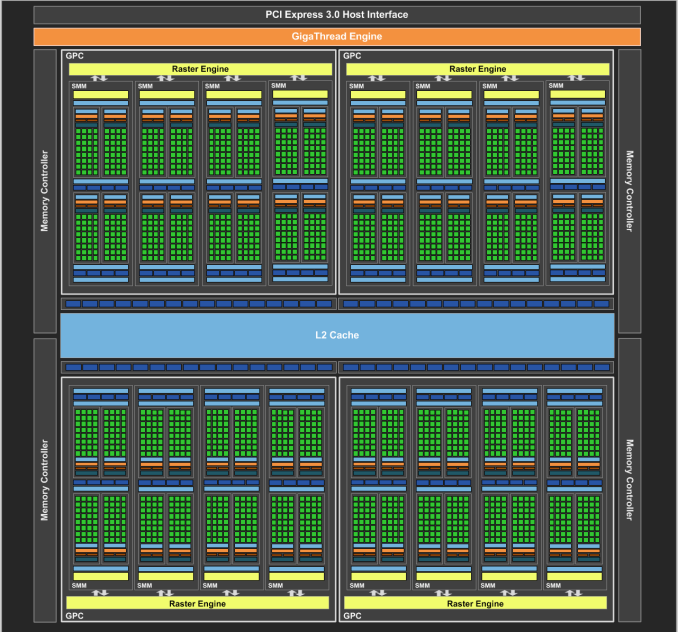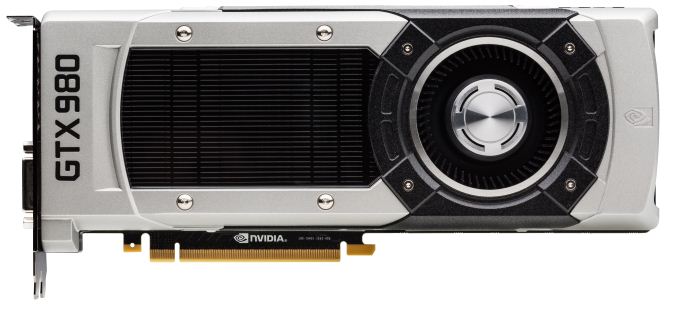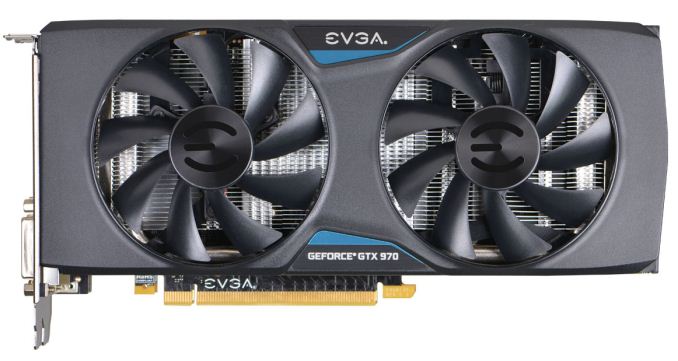The NVIDIA GeForce GTX 980 Review: Maxwell Mark 2
by Ryan Smith on September 18, 2014 10:30 PM ESTLaunching Today: GTX 980 & GTX 970
Now that we’ve had a chance to take a look at the architectural and feature additions found in Maxwell 2 and GM204, let’s talk about the products themselves.
Today NVIDIA will be launching 2 products. These are the GeForce GTX 980 and GeForce GTX 970. As with past 80/70 parts this is a two tier launch, with GTX 980 being NVIDIA’s new flagship card and 1st tier GM204 card, while GTX 970 offers 2nd tier performance at much lower pricing.
| NVIDIA GPU Specification Comparison | ||||||
| GTX 980 | GTX 970 (Corrected) | GTX 780 Ti | GTX 770 | |||
| CUDA Cores | 2048 | 1664 | 2880 | 1536 | ||
| Texture Units | 128 | 104 | 240 | 128 | ||
| ROPs | 64 | 56 | 48 | 32 | ||
| Core Clock | 1126MHz | 1050MHz | 875MHz | 1046MHz | ||
| Boost Clock | 1216MHz | 1178MHz | 928Mhz | 1085MHz | ||
| Memory Clock | 7GHz GDDR5 | 7GHz GDDR5 | 7GHz GDDR5 | 7GHz GDDR5 | ||
| Memory Bus Width | 256-bit | 256-bit | 384-bit | 256-bit | ||
| VRAM | 4GB | 4GB | 3GB | 2GB | ||
| FP64 | 1/32 FP32 | 1/32 FP32 | 1/24 FP32 | 1/24 FP32 | ||
| TDP | 165W | 145W | 250W | 230W | ||
| GPU | GM204 | GM204 | GK110 | GK104 | ||
| Transistor Count | 5.2B | 5.2B | 7.1B | 3.5B | ||
| Manufacturing Process | TSMC 28nm | TSMC 28nm | TSMC 28nm | TSMC 28nm | ||
| Launch Date | 09/18/14 | 09/18/14 | 11/07/13 | 05/30/13 | ||
| Launch Price | $549 | $329 | $699 | $399 | ||
Starting with the GeForce GTX 980, this is a fully enabled GM204 part. This means that 16 SMMs are enabled (2048 CUDA cores), as are all 64 ROPs and the full 256-bit memory bus. It is in other words GM204 at its best.
For clockspeeds NVIDIA is shipping GTX 980 with a base clockspeed of 1126MHz, a boost clockspeed of 1216MHz, and in our samples we have found the maximum clockspeed (highest stock boost bin) to be 1252MHz. This is a higher set of clockspeeds than any NVIDIA consumer GPU thus far, surpassing GTX 770, GTX Titan Black, and GTX 750 Ti. Curiously NVIDIA’s self-defined (and otherwise arbitrary) boost clock is much higher than on past parts; normally it would only be 50MHz or so above the base clock. This indicates that NVIDIA is getting more aggressive with their boost clock labeling and are picking values much closer to the card’s maximum clockspeed. This is a subject we will be revisiting later.
Meanwhile the memory clock stands at 7GHz, the same as with NVIDIA’s past generation of high-end cards. With GDDR5 clockspeeds all but tapped out, NVIDIA appears to have reached the limits of GDDR5 as a technology, hence their long-term interest in HBM for future architectures and improved color compression for current architectures. In any case this 7GHz of GDDR5 is attached to a 256-bit memory bus, and is populated with 4GB of VRAM. NVIDIA for the longest time has held to 2GB/3GB of memory for their cards, so it is a welcome sight to see that they are now making 4GB their standard, especially if they are going to target 4K gaming.
For power delivery GTX 980 has a rated TDP of 165W. This is significantly lower than the 250W TDPs of the GTX 780/780Ti/Titan and even the 225W TDP of the GTX 770, and heavily contributes to NVIDIA’s overall power efficiency advantage. Meanwhile NVIDIA does not specify an idle TDP, however in our testing idle power usage is lower than ever for a high-end NVIDIA card, indicating that NVIDIA should have it down to the single watt range.
Moving on, we have the GTX 980’s lower price, lower performance counterpart, the GTX 970. Compared to GTX 980, GTX 970 drops 3 of the SMMs, reducing its final count to 13 SMMs or 1664 CUDA cores. It also sheds part of a ROP/L2 cache partition while retaining the 256-bit memory bus of its bigger sibling, bringing the ROP count down to 56 ROPs and the L2 cache down to 1.75MB, a configuration option new to Maxwell.
As expected, along with the reduction in SMMs clockspeed is also reduced slightly for GTX 970. It ships at a base clockspeed of 1050MHz, with a boost clockspeed of 1178MHz. This puts the theoretical performance difference between it and the GTX 980 at about 85% of the ROP performance or about 79% of the shading/texturing/geometry performance. Given that the GTX 970 is unlikely to be ROP bound with so many ROPs, the real world performance difference should much more closely track the 79% value, meaning there is a significant performance delta between the GTX 980 and GTX 970. Elsewhere the memory configuration is unchanged from GTX 980. This means we’re looking at 4GB of GDDR5 clocked at 7GHz, all on a 256-bit bus.
GTX 970’s TDP meanwhile is lower than GTX 980’s thanks to the reduced clockspeeds and SMM count. The stock GTX 970 will be shipping with a TDP of just 145W, some 80W less than GTX 770. NVIDIA’s official designs still include 2 6-pin PCIe power sockets despite the fact that the card should technically be able to operate on just one; it is not clear at this time whether this is for overclocking purposes (150W would leave almost no power headroom) or for safety purposes since NVIDIA would be so close to going over PCIe specifications.
Due to the launch of the GTX 980 and GTX 970, NVIDIA’s product lineup will be changing to accommodate these cards. GTX 780 Ti, GTX 780, and GTX 770 are all being discontinued; their replacements offer better performance at better prices for lower power consumption. GTX 980 will be launching at $550, meanwhile GTX 970 will be launching at the surprisingly low price of $329, some 40% cheaper than GTX 980. On a historical basis GTX 980 is a bit higher than most of the past GTX x80 cards – which are often launched at $500 – while GTX 970 immediately slots in to GTX 770’s old price.
NVIDIA’s target market for the GTX 900 series will be owners of GTX 600/500/400 series cards and their AMD equivalents. GTX 980 and GTX 970 are faster than their 700 series predecessors but not immensely so, and as a result NVIDIA does not expect 700 series owners to want to upgrade so soon. Meanwhile 600 series owners and beyond are looking at 70%+ improved performance for cards at the same tier, along with some degree of a reduction in power consumption.
For today’s launch NVIDIA will be doing a reference launch of the GTX 980, so reference cards will be well represented while production of customized cards ramps up. Meanwhile GTX 970 is a pure virtual launch, meaning there will not be any reference cards at all. NVIDIA’s partners will be launching with customized designs right away, many of which will be carried over from their GTX 600/700 card designs. This will be a hard launch and cards should be readily available, and while NVIDIA should have no problem producing GM204 GPUs on the very mature TSMC 28nm process, it is difficult to predict just how well supplies will hold out.
On the competitive basis NVIDIA’s direct competition for the GTX 980 and GTX 970 will be split. GTX 980 is an immediate challenger for the Radeon R9 290X, AMD’s flagship single-GPU card which outside of a couple of sales continues to be priced around $499. GTX 970’s competition meanwhile will be split between the Radeon R9 290 and Radeon R9 280X. From a performance perspective the R9 290 is going to be the closer competitor, though it's priced around $399. Meanwhile the R9 280X will undercut the GTX 970 at around $279, but with much weaker performance.
NVIDIA for their part will not be running any promotions or bundles for the GTX 900 series, so what you see is what you get. Otherwise AMD will have their continuing Never Settle Forever bundle in play, which offers up to 3 free games in order to add value to the overall product.
Finally, there will be price cuts for the GTX 700 series. Officially GTX 760 stays in production with a new MSRP of $219. Meanwhile GTX 770, GTX 780, and GTX 780 Ti will go on clearance sale at whatever prices retailers can manage, and are still part of NVIDIA’s Borderlands bundle offer. That said, from a performance and power efficiency angle, the GTX 900 series is going to be a much more desirable product line.
| Fall 2014 GPU Pricing Comparison | |||||
| AMD | Price | NVIDIA | |||
| Radeon R9 295X2 | $1000 | ||||
| $550 | GeForce GTX 980 | ||||
| Radeon R9 290X | $500 | ||||
| Radeon R9 290 | $400 | ||||
| $330 | GeForce GTX 970 | ||||
| Radeon R9 280X | $280 | ||||
| Radeon R9 285 | $250 | ||||
| Radeon R9 280 | $220 | GeForce GTX 760 | |||













274 Comments
View All Comments
mesahusa - Tuesday, September 23, 2014 - link
Nvidia and AMD havent moved to 22 because they don't have the funding. Intel has tens of billions to blow away in R&D. Broadwells going to be released in 2015, and its 14nm.Hrel - Monday, September 22, 2014 - link
In light of Nvidia not even trying to reduce manufacturing nodes It would be really nice to see them go on the offensive in the price war. $300 for the GTX980, everything lower from there. Probably not now, but like, spring 2015, that'd be great! Make good and sure to wipe out all the hold outs (like myself) keeping their old cards because they still play everything they play on 1080p. Kinda, get all your customers caught up on hardware in the same upgrade time frame.Then when they finally do drop nodes they can focus on making every card they sell run games at 8K resolution.
Nfarce - Monday, September 22, 2014 - link
Hate to break the news to you, but if you want to game at high level (above 1080p), you need to pay at high level. There is nothing new about that in the entire history of PC enthusiast building and gaming either for those of us who remember making the "huge leap" from a 15" 1024x768 resolution CRT monitor to a whopping 19" 1600x1200 CRT monitor. At least not in the 20 years since I've been involved with it anyway.Besides all that, that's why GPU makers offer cards for different budgets. If you can't afford their top tier products, you can't afford to game top tier. Period and end of discussion.
tuxRoller - Monday, September 22, 2014 - link
It seems as though the big improvement nvidia has made is to enable cpu-level scheduling/dvfs granularity into their chip. However, once all cores are engaged it ends up using as much power as its predecessor (see tomshardware).What I really want to know is how much of this due to purely driver-level changes.
yhselp - Tuesday, September 23, 2014 - link
Exceptional design. The sad thing is that NVIDIA will take forever to release a 30 SMM Maxwell GPU and once it finally does, it would cost a ton; even later on when they release a "budget" version for an unreasonable price of around $650 it would be too late - the great performance potential of today wouldn't be so great tomorrow. Striving for and building amazing GPUs is the right way forward, not empowering the people with them is a crime. Whatever happened to $500 flagship products?Rhodie - Wednesday, September 24, 2014 - link
Just got a GTX970, and only latest Nvidia drivers will install for 9xx series cards it seems. Unfortunately the latest drivers totally screw up some programs that use CUDA, seem to hide itspresence from programs lile Xillisoft Video Convertor Ultimate:-/ No response of course from either Nvidia or Xillisoft regarding the problem. Wonder how many other programs the drivers break?
garadante - Thursday, September 25, 2014 - link
Geeze. Anandtech, do an updated best value graphics card list because since the launch of the 970/980 retailers are giving some serious price cuts to 770/780/780 Ti's. Newegg has a 780 for less than $300 after rebate and just a hair over $300 before rebate. I'm seeing 780 Ti's for ~$430 and 770s for ~$240. I am amazed to see price cuts this deep since I haven't seen them the last several generations and considering how overpriced these cards were. But while supplies last and prices hold/drop, this completely flips price/performance on it's head. I feel bad recommending an AMD 290 Tri-X to a friend a couple months back now. xDgaradante - Thursday, September 25, 2014 - link
Please do an updates best value graphics card* Where are my manners! D:jman9295 - Friday, September 26, 2014 - link
Newegg has an Asus DirectCU II GTX 780 selling in the $290 range after a mail in rebate, promo code and discount. It also comes with a pre-order copy of the new Borderlands game. That has to be the best value to performance GPU out right now. It is almost a full $100 less than the cheapest non-reference R9 290 on newegg and $40 less than the cheapest reference R9 290 which is crazy since this same Asus GTX 780 was selling for over $550 just last month with no free games (and still is on Amazon for some reason).mixer4x - Thursday, September 25, 2014 - link
I feel bad for having just bought the 290 tri-x just a month ago! =(I bought it because you never know when the new cards will be released and how much they will cost. Unfortunately, the new cards came out too soon!